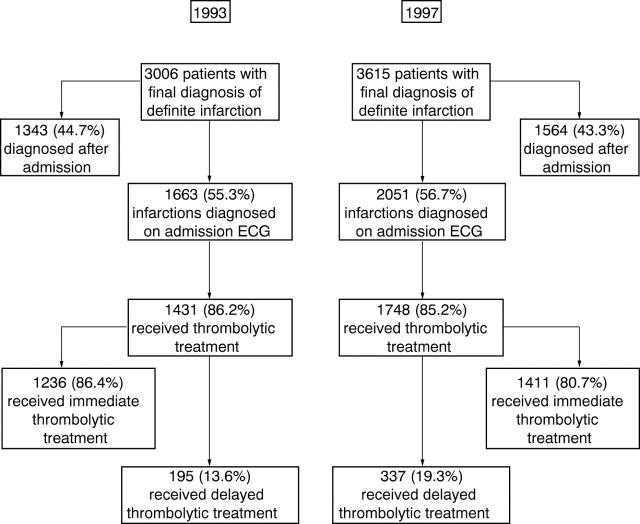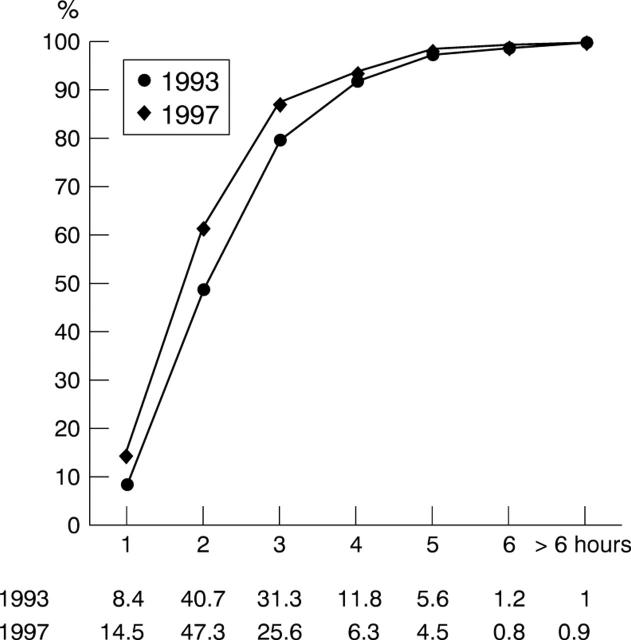Abstract
OBJECTIVE—To evaluate trends in provision of thrombolytic treatment between 1993 and 1997. DESIGN—Observational study. SUBJECTS—3714 patients in 15 UK hospitals who had an admission diagnosis of myocardial infarction. MAIN OUTCOME MEASURES—Changes in prehospital and hospital delay before thrombolytic treatment; use of emergency services. RESULTS—Between 1993 and 1997 the proportion of patients who called for help within 30 minutes of the onset of symptoms fell from 42.6% to 36.0%; difference 6.6% (95% confidence intervals (CI) 3.3% to 10%). The direct use of the emergency service by patients and by doctors sending an ambulance without seeing the patient increased by 18.9%. Patients given thrombolytic treatment within 90 minutes of calling for help increased from 28.2% to 39.1%; difference 10.9% (95% CI 7.2% to 14.7%). Over the same period the proportion of patients treated in emergency departments increased from 4.4% to 17.3%, and the median delay from arrival to treatment in emergency departments fell from 53 to 36 minutes. Median delays for patients treated in cardiac care units after assessment in the emergency department fell from 63 to 54 minutes. CONCLUSION—Between 1993 and 1997 there was an increase in the proportion of patients with definite infarction having thrombolytic treatment within 90 minutes of a call for help. This was mainly the result of greater use of the emergency service and more rapid treatment of a larger proportion of eligible patients in emergency departments. Longer delays by patients have cancelled out some of this improvement. Keywords: myocardial infarction; thrombolytic treatment
Full Text
The Full Text of this article is available as a PDF (103.1 KB).
Figure 1 .
Patient population included in the study.
Figure 2 .
Cumulative percentage of patients having thrombolytic treatment after a call for help in 1993 and 1997. Lower panel indicates the proportion having treatment within each interval of one hour.
Selected References
These references are in PubMed. This may not be the complete list of references from this article.
- Birkhead J. S. Time delays in provision of thrombolytic treatment in six district hospitals. Joint Audit Committee of the British Cardiac Society and a Cardiology Committee of Royal College of Physicians of London. BMJ. 1992 Aug 22;305(6851):445–448. doi: 10.1136/bmj.305.6851.445. [DOI] [PMC free article] [PubMed] [Google Scholar]
- Blohm M. B., Hartford M., Karlson B. W., Luepker R. V., Herlitz J. An evaluation of the results of media and educational campaigns designed to shorten the time taken by patients with acute myocardial infarction to decide to go to hospital. Heart. 1996 Nov;76(5):430–434. doi: 10.1136/hrt.76.5.430. [DOI] [PMC free article] [PubMed] [Google Scholar]
- Boersma E., Maas A. C., Deckers J. W., Simoons M. L. Early thrombolytic treatment in acute myocardial infarction: reappraisal of the golden hour. Lancet. 1996 Sep 21;348(9030):771–775. doi: 10.1016/S0140-6736(96)02514-7. [DOI] [PubMed] [Google Scholar]
- Burnett R. E., Blumenthal J. A., Mark D. B., Leimberger J. D., Califf R. M. Distinguishing between early and late responders to symptoms of acute myocardial infarction. Am J Cardiol. 1995 May 15;75(15):1019–1022. doi: 10.1016/s0002-9149(99)80716-4. [DOI] [PubMed] [Google Scholar]
- Gurwitz J. H., McLaughlin T. J., Willison D. J., Guadagnoli E., Hauptman P. J., Gao X., Soumerai S. B. Delayed hospital presentation in patients who have had acute myocardial infarction. Ann Intern Med. 1997 Apr 15;126(8):593–599. doi: 10.7326/0003-4819-126-8-199704150-00001. [DOI] [PubMed] [Google Scholar]
- Solomon C. G., Lee T. H., Cook E. F., Weisberg M. C., Brand D. A., Rouan G. W., Goldman L. Comparison of clinical presentation of acute myocardial infarction in patients older than 65 years of age to younger patients: the Multicenter Chest Pain Study experience. Am J Cardiol. 1989 Apr 1;63(12):772–776. doi: 10.1016/0002-9149(89)90040-4. [DOI] [PubMed] [Google Scholar]
- Somauroo J. D., McCarten P., Appleton B., Amadi A., Rodrigues E. Effectiveness of a 'thrombolysis nurse' in shortening delay to thrombolysis in acute myocardial infarction. J R Coll Physicians Lond. 1999 Jan-Feb;33(1):46–50. [PMC free article] [PubMed] [Google Scholar]
- Weaver W. D., Simes R. J., Betriu A., Grines C. L., Zijlstra F., Garcia E., Grinfeld L., Gibbons R. J., Ribeiro E. E., DeWood M. A. Comparison of primary coronary angioplasty and intravenous thrombolytic therapy for acute myocardial infarction: a quantitative review. JAMA. 1997 Dec 17;278(23):2093–2098. [PubMed] [Google Scholar]
- Weston C. F., Penny W. J., Julian D. G. Guidelines for the early management of patients with myocardial infarction. British Heart Foundation Working Group. BMJ. 1994 Mar 19;308(6931):767–771. doi: 10.1136/bmj.308.6931.767. [DOI] [PMC free article] [PubMed] [Google Scholar]




